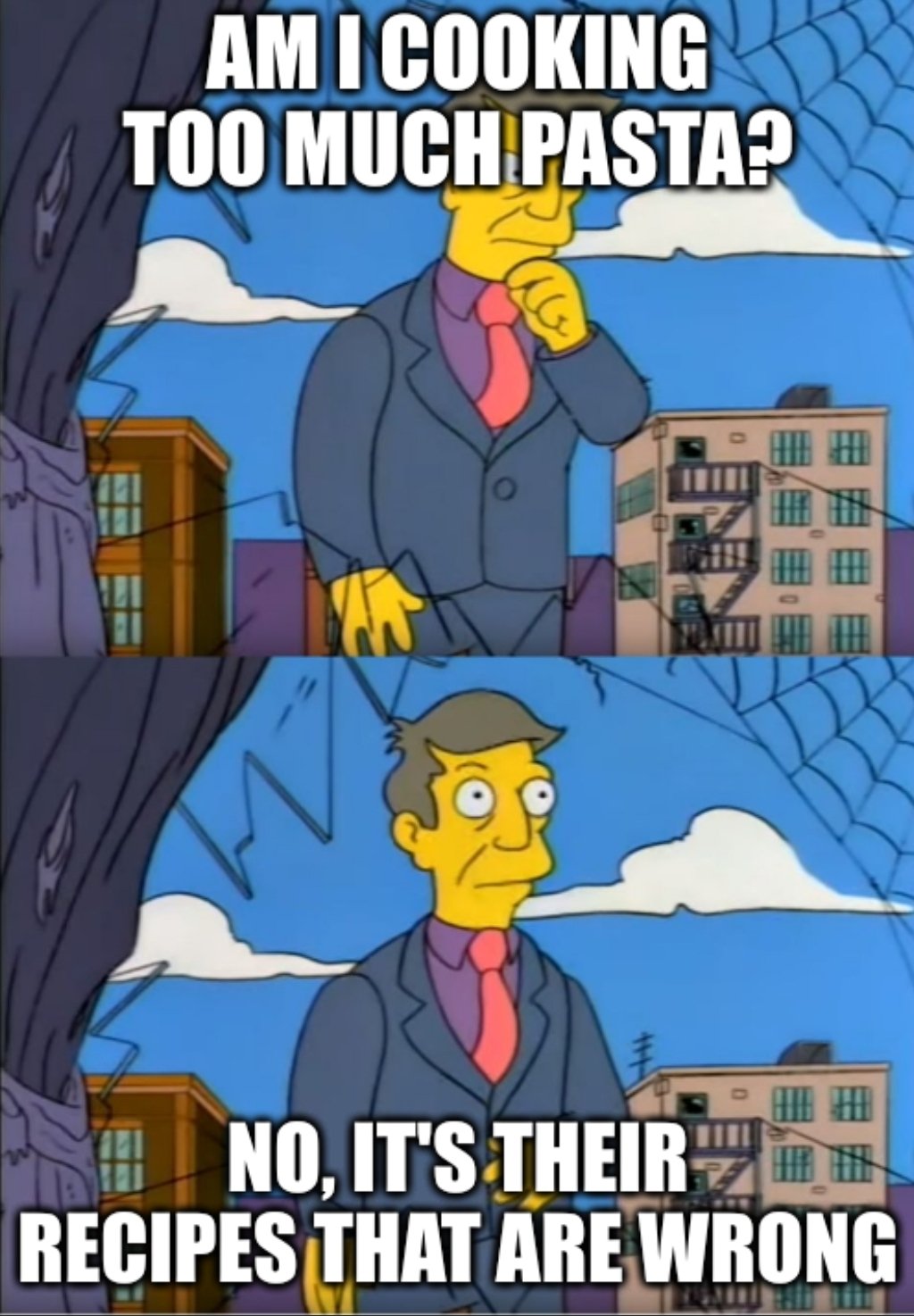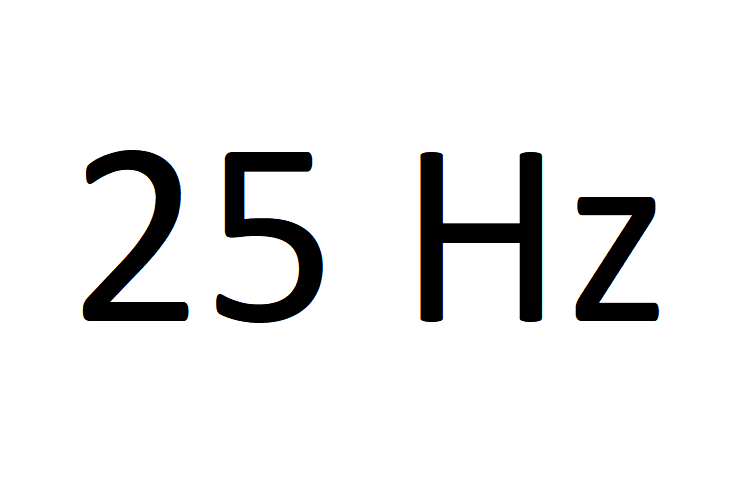- cross-posted to:
- [email protected]
- cross-posted to:
- [email protected]
Do you cook your pasta in a large pot, with plenty of boiling water, and a good amount of salt? Usually I just stir once just after putting the pasta in, and I never have noodles sticking together.
It depends on the pasta (form, freshness, self-made… etc). Some has to be stirred 3-4 times others just once, in my experience.
My pot would have to be 3x its size to fit the amount of water a single package of pasta says I should use.
1kg to 10l
Do you have a bathtub in your stove?No, but 1kg of pasta? Are you feeding a battalion?
I usually make food for a few days
Then investing in a large pot would make sense.
I have one though
Matter of definition really
Definition of what?
Definition of battalion
Only the best musicians blame their pot.
TBF, pot has played a big role in the making of some great music
As others have already said, that is a lot of pasta. If you regularly cook volumes like that, it would really make sense to invest in a large pot as well. A cheap 10l pot will do just fine for boiling pasta, and it sounds like you would get plenty of use out of it.
1 kg of dry pasta is enough for 10 people! Do you often cook for that many people? (Genuine question)
Not in my experience, I usually count 200g per person
That’s a LOT of pasta per person. Not unheard of, but still a lot
Me going through this thread

That’d be two people, five meals each so a few days. That’s how I usually do it
This is making me chuckle, because I just did this last night for a dinner party. It was a hell of a lot of pasta for 7. I kept it moving, even in my big stock pot. Only a few strands stuck to the bottom. We have leftovers.
I usually cook a quarter of that for the two of us, sometimes half if I want to eat for a couple of days.
2lbs/1 kg is a lot.
I do have a 10 L pot, I use it for making stock and beer
I have a 12 gallon pot I use for the same.
If it didn’t have the spout off the front I’d probably use it for a lot more stuff like huge batches of chili (for canning). I end up using multiple pots for that instead because I don’t want to have to clean around the dumb thing.
But the drain tube makes it soooo easy to strain the broth.

Me who never stirs and never gets sticky pasta…
Stop using butter.
This meme is about boiling pasta. You butter before you boil? Weird.
Butter is delicious though
No, you are.
Gross, people do that?
it’s indeed gross to stop using butter
The oil keeps the water from boiling over. The downside is that the sauce won’t stick as well.
It’s not salting your water, nor the water volume to pasta ratio, nor if the water is boiling or not, nor oil in the water, but stirring early in the cooking process that will prevent sticking.
From the great Kenji Lopez-Alt:
Pasta is made up of flour, water, and sometimes eggs. Essentially, it’s composed of starch and protein, and not much else. Now starch molecules come aggregated into large granules that resemble little water balloons. As they get heated in a moist environment, they absorb more and more water until they finally burst, releasing the starch molecules into the water. That’s why pasta always seems to stick together at the beginning of cooking—it’s the starch molecules coming out and acting as a sort of glue, binding the pieces to each other, and to the pot.
…
The problem is that first stage of cooking—the one in which starch molecules first burst and release their starch. With such a high concentration of starch right on the surface of the pasta, sticking is inevitable. However, once the starch gets rinsed away in the water, the problem is completely gone.
So the key is to stir the pasta a few times during the critical first minute or two. After that, whether the pasta is swimming in a hot tub of water or just barely covered as it is here, absolutely no sticking occurs. I was able to clean this pot with a simple rinse.
Wow, this guy is amazing!
Yep, I really like how he applies the scientific method to cooking. Some of my favourites are how he’s found the perfect way to boil an egg, cook steaks and roasts (dry brine, reverse sear), and make chocolate chip cookies (he made over 1500 cookies testing how changing each variable changed the final cookie).
Yeah you only need to do it once in the beginning. Say a seconc time to make time pass.
Not salting the water is a crime against humanity though so be aware.
Oh yes, I’m not saying don’t season your water. Just that seasoning the water on its own is not a way to prevent pasta sticking.
My biggest gripe with cooking instructions is the non-specificity. “Stir pasta frequently”? How frequently? How continuously? Tell me in unit Hertz
I won’t accept my pasta at anything lower than 120Hz.
Not sure your pasta will survive that kind of speeds…
They just pasta way
Oh gnocchi didn’t.
only 120hz?! I refuse to eat any pasta below 2.4ghz
Those are some loose standards… I only accept pasta at 1.21 Jiggawatts and 88mph.
Just imagine the chaos when you run the microwave at the same time!
The human eye cannot see more than 24Hz, so why bother
Sooo…just curious how you explain this?

Just another of those internet image optical illusions. You won’t be fooling anyone on here 🧐
I don’t understand the basis of the 24Hz limit rumor. My monitors are 144Hz, and if I limit them to 60Hz and move my mouse around I see fewer residual mouse cursors “after-images” than I do at 144Hz. That’s a simplified test that shows that the eye can perceive motion artifacts beyond 60Hz.
The eye can perceive LEDs that are rectified at 60Hz AC, it’s very annoying.
I could never tell if people who were claiming not seeing more than the 24 Hz/FPS thing were serious or just excusing poor game optimization. They were either fanboys defending a poor job of a product, or simply had terrible eyes. But I think even with the latter you’d still be able to tell the difference in smoothness.
It’s one of those things that once you experience a higher framerate in games it’s very hard to go back to a lower setting.
I find it hard to get used to in movies/shows though. My TV has an option to insert frames for smoother playback to make it appear a higher Hz, but it often looks unnatural. It was hard getting used to The Hobbit movie (I think it was Desolation of Smaug) that was in 48 FPS. And Avatar: Way of Water was constantly switching between lower and higher frames for regular and action scenes, it was such a jarring experience.
iirc 24hz is just the minnimum thta the movie industry found creates the illusion of a moving image.
I believe 24Hz works in movies because the way cinemas are set up. The image projected onto canvas in a dark/dim room “burn” in (not sure what the correct term is) which can make it appear smoother. This is why they can get away with it in cinemas. Plus it’s also a consistent 24Hz, which in games (and Way of Water) isn’t.
People used this excuse for games, to make games more “cinematic”, but that was just an absolute horseshit excuse for games being poorly optimised. Especially if the framerate wasn’t locked to 24FPS, and because home monitors and TVs don’t work the same as cinema projectors.
I’m sure if all cinemas and media would move to a higher framerate/Hz it would eventually just feel normal though. It just often takes a lot of time getting used to, especially for cinema experiences.
I used to have a 4k tv I used as a monitor. It was 60hz. When I was tired, my eyes would vibrate back and forth trying to play nice with the frame rate, blurring everything up. Very difficult to read. Huge increase in headaches.
Switched to 120hz tv (all other specs equal) and the problem stopped entirely and hasn’t resurfaced in the 6 years since.
A person may not notice it directly, but it does matter.
I don’t really notice in movies and stuff but those are so damned chaotic anyway that it probably really doesn’t matter as much. (I don’t like live action, it’s difficult af to follow)
I haven’t noticed in games really but i mostly play console where that’s not really something you can usually tweak
It’s often weird how people don’t notice it much when you turn a setting on or off. But then I usually whip out the UFO site and they’re immediately convinced (it’s also easier to explain).
I have to say that on the PS5 the framerate differences have been quite noticeable. Especially first-party titles that support performance mode to go up to 60+ FPS instead of a usually locked 30, like in God of War and Horizon games.
I haven’t really run into ps5 issues, but then physical media is very difficult to find for 5, so I only have 4 games for ps5 vs 50+ for ps4 (I don’t buy digital games, ever).
But I guess I don’t really pay much attention to it either. As long as it works well enough I don’t usually mess with the display settings other than turning gama waaaaaaay up so I can see shit properly… my tv doesn’t support hdr, which I think became standard in 2017, or anything newer than that which newer games are built to use, so I mostly just leave the defaults alone. I definitely notice some games are smoother than others, but that could just as easily be the texture pack or resource utilization as well.
Back when I was playing games on my phone, I’d actually turn down the refresh… sure this game can run at 120, but it can also run at 30 or 60, let’s see what the lowest I can stand is! I don’t do that anymore, but it was good for battery life :)
I think it’s the limit for what most people can see as jittery motion. You may be able to differentiate between higher FPS settings, but above 24 hertz most people shouldn’t be able to see discrete steps.
That’s at least how I’ve come to understand it
Your eyes are not digital. Nothing physical really is. Think about a camera flash. They can get well under 3.33ms, meaning over 300fps, and you can still see it clearly (and painfully). Same for a monitor, it also has a “response time”. It is how long it takes for a pixel to transition color. (Usually “gray to gray”, as in one shade of gray to another. Black to white would be longer, as is for eyes.)
So ofc you would see all the mice.
It’s also why motion blur is a thing, even though it was usually implemented incorrectly. Seeing every motion on a tv or monitor in perfect sharpness feels weird, because they are pictures not actual movements.
Your brain makes movements out of it all.
Anyway: 16 is minimum, 24 is good for most movies, 30 for slower games, 60 minimum for fps (75 and above for faster fps, even though i played xonotic on 45), 120 for vr.
24hz is the lower limit. People will perceive 24hz as a smooth sequence, especially with motion blur, while anything below it will start to look choppy. Of course humans can perceive higher frequencies. But 24hz became the standard because celluloid film is expensive especially in the early days of cinema. The less frames you need to shoot the less film you need to buy and develop. And film back then was probably not sensitive enough for the lower exposure times that come with higher frame rates.
No it can see much more. Bonus: your brain can ‘see’ more than 100hz too. Google bundesen tva. Source i worked on programs to measure it for my gfs phd. Also i play fps :D
What kind of dumb instructions are that?
Stirring exactly once is enough in most cases.
Maybe a graph of how strong the bond gets over time for 2 elements?
Is this a meme I’m too Italian to understand?
Yeah, I also don’t get it. I don’t stir pasta, maybe once in the middle. It never sticks.
Skill issue

Gift
I have actually never seen this before. Other comments are saying its because you dont salt your water and i do so probably thats why. It also makes the taste better so overall recommended.
Mario Batali over here.
?
You can add some oil so pasta won’t also stick when you have cold leftovers. I add both oil and salt in the very beginning, because there’s no reason to not do that, and I have a feeling of the right amount compared to the amount of water.
And I stir once, about a minute after putting the pasta in, because something tends to stick to the bottom in the very beginning. Afterwards, it’s just not necessary.You ever heard the saying “like oil and water”? Oil doesn’t mix with water. It floats on the surface. Adding it just wastes 100% of the oil.
deleted by creator
Oh, thank you for providing me with this rare knowledge. But what happens while you boil pasta, is pasta turning around and soaking the oil in. I wouldn’t be doing that if it wouldn’t help with pasta stickiness.
And as other people comment here, oil gets into pasta so you can have a problem with sauce not soaking in, but when I’m making something like bolognese, I sometimes pour pasta into the frying pan with the sauce, so it’s getting there for sure.But what happens while you boil pasta, is pasta turning around and soaking the oil in.
That’s not what happens
wouldn’t be doing that if it wouldn’t help with pasta stickiness.
It doesn’t, it prevents boilover
A wooden spoon across the top of the pot prevents boilover, so why waste the oil?
Yeah people say that but it has literally never worked for me lmao. Great way for me to make a mess
Okay, okay, oil doesn’t help me at all, what am I doing!
I add both oil and salt in the very beginning, because there’s no reason to not do that.
If you really like to impregnate your pasta, so that it won’t absorb your sauce (or less well), then you are right about the there-is-no-reason-part in your answer.
Y’all need to salt your water.
It prevents nearly all the sticking and it makes pasta delicious
It’s not the salt that prevents the sticking. You use a larger pot with plenty of water. Still delicious though :P
Yea, and not cooking it for too long.
And while you’re at it, shell out the extra 50 cents or whatever for the bronze cut pasta. It has a much nicer texture and allegedly makes sauce adhere to the pasta more.
Bronze cut cavatappi is the superior macaroni.
It’s really the first couple minutes that are critical
Salty like the ocean

Lidia taught me that
Is bullshit you don’t want that much salt

I’m not saying don’t salt it, just not as salty as the ocean, you just don’t need that much
You do in the water. The pasta won’t absorb all of it
I’ve tried boiling pasta in ocean water. They were inedible.
If the ocean is the baltic sea then it makes sense as it has salt content ranging from 0.5~1.5
I’ve never once had pasta sticking together in the pot, regardless of what I do.
Removed by mod
What kind of pasta do you use?
137 times more powerful than the Electromagnetism you try and use to tear them apart, behold the Strong Pasta Friendship Force!
It’s that goblin fuck from sin city having an orgy.
That goblin fuck doesn’t have the tools for a proper orgy
Your recommended posts, all in one place
Dat feel





















